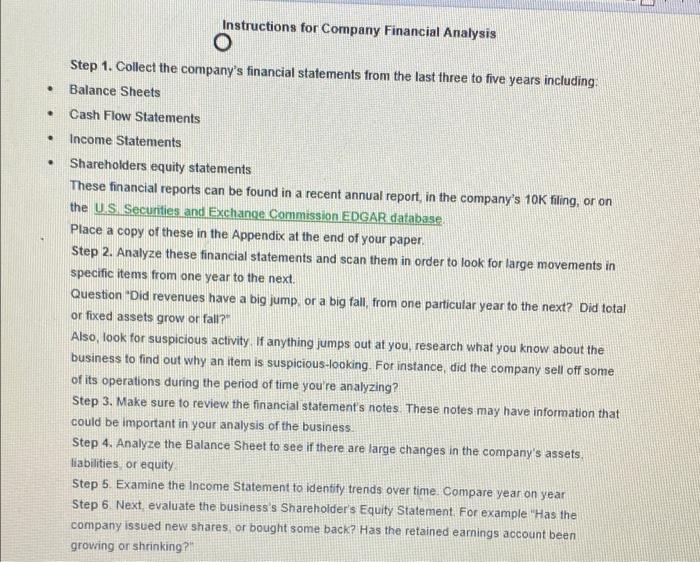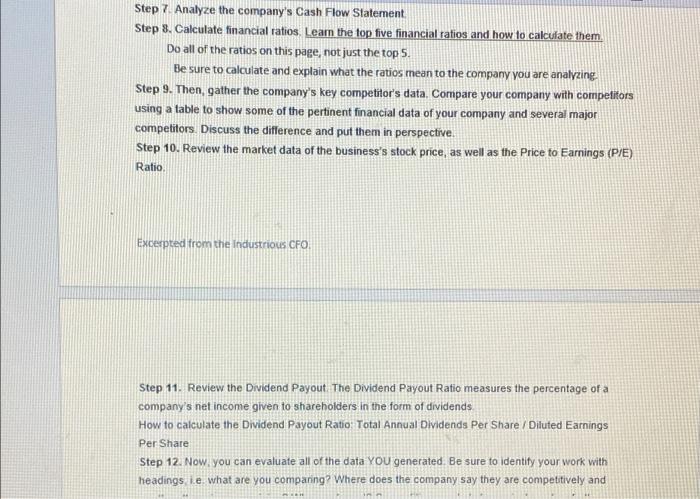Answered step by step
Verified Expert Solution
Question
1 Approved Answer
Walmart Inc is the company that has to be analyze . . . . Instructions for Company Financial Analysis O Step 1. Collect the company's
Walmart Inc is the company that has to be analyze 

. . . . Instructions for Company Financial Analysis O Step 1. Collect the company's financial statements from the last three to five years including Balance Sheets Cash Flow Statements Income Statements Shareholders equity statements These financial reports can be found in a recent annual report in the company's 10K filing, or on the US Securities and Exchange Commission EDGAR database Place a copy of these in the Appendix at the end of your paper. Step 2. Analyze these financial statements and scan them in order to look for large movements in specific items from one year to the next Question "Did revenues have a big jump, or a big fall, from one particular year to the next? Did total or fixed assets grow or fall?" Also, look for suspicious activity. If anything jumps out at you, research what you know about the business to find out why an item is suspicious-looking For instance, did the company sell off some of its operations during the period of time you're analyzing? Step 3. Make sure to review the financial statements notes. These notes may have information that could be important in your analysis of the business. Step 4. Analyze the Balance Sheet to see if there are large changes in the company's assets. liabilities or equity Step 5. Examine the Income Statement to identify trends over time. Compare year on year Step 6. Next, evaluate the business's Shareholder's Equity Statement For example "Has the company issued new shares or bought some back? Has the retained earnings account been growing or shrinking?"| Step 7. Analyze the company's Cash Flow Statement Step 8. Calculate financial ratios, Leam the top five financial ratios and how to calculate them Do all of the ratios on this page, not just the top 5 Be sure to calculate and explain what the ratios mean to the company you are analyzing Step 9. Then, gather the company's key competitor's data. Compare your company with competitors using a table to show some of the pertinent financial data of your company and several major competitors Discuss the difference and put them in perspective. Step 10. Review the market data of the business's stock price, as well as the Price to Earnings (P/E) Ratio. Excerpted from the industrious CFO Step 11. Review the Dividend Payout The Dividend Payout Ratio measures the percentage of a company's net income given to shareholders in the form of dividends How to calculate the Dividend Payout Ratio: Total Annual Dividends Per Share / Diluted Earnings Per Share Step 12. Now you can evaluate all of the data YOU generated. Be sure to identity your work with headings ie what are you comparing? Where does the company say they are competitively and . . . . Instructions for Company Financial Analysis O Step 1. Collect the company's financial statements from the last three to five years including Balance Sheets Cash Flow Statements Income Statements Shareholders equity statements These financial reports can be found in a recent annual report in the company's 10K filing, or on the US Securities and Exchange Commission EDGAR database Place a copy of these in the Appendix at the end of your paper. Step 2. Analyze these financial statements and scan them in order to look for large movements in specific items from one year to the next Question "Did revenues have a big jump, or a big fall, from one particular year to the next? Did total or fixed assets grow or fall?" Also, look for suspicious activity. If anything jumps out at you, research what you know about the business to find out why an item is suspicious-looking For instance, did the company sell off some of its operations during the period of time you're analyzing? Step 3. Make sure to review the financial statements notes. These notes may have information that could be important in your analysis of the business. Step 4. Analyze the Balance Sheet to see if there are large changes in the company's assets. liabilities or equity Step 5. Examine the Income Statement to identify trends over time. Compare year on year Step 6. Next, evaluate the business's Shareholder's Equity Statement For example "Has the company issued new shares or bought some back? Has the retained earnings account been growing or shrinking?"| Step 7. Analyze the company's Cash Flow Statement Step 8. Calculate financial ratios, Leam the top five financial ratios and how to calculate them Do all of the ratios on this page, not just the top 5 Be sure to calculate and explain what the ratios mean to the company you are analyzing Step 9. Then, gather the company's key competitor's data. Compare your company with competitors using a table to show some of the pertinent financial data of your company and several major competitors Discuss the difference and put them in perspective. Step 10. Review the market data of the business's stock price, as well as the Price to Earnings (P/E) Ratio. Excerpted from the industrious CFO Step 11. Review the Dividend Payout The Dividend Payout Ratio measures the percentage of a company's net income given to shareholders in the form of dividends How to calculate the Dividend Payout Ratio: Total Annual Dividends Per Share / Diluted Earnings Per Share Step 12. Now you can evaluate all of the data YOU generated. Be sure to identity your work with headings ie what are you comparing? Where does the company say they are competitively and 

Step by Step Solution
There are 3 Steps involved in it
Step: 1

Get Instant Access to Expert-Tailored Solutions
See step-by-step solutions with expert insights and AI powered tools for academic success
Step: 2

Step: 3

Ace Your Homework with AI
Get the answers you need in no time with our AI-driven, step-by-step assistance
Get Started


